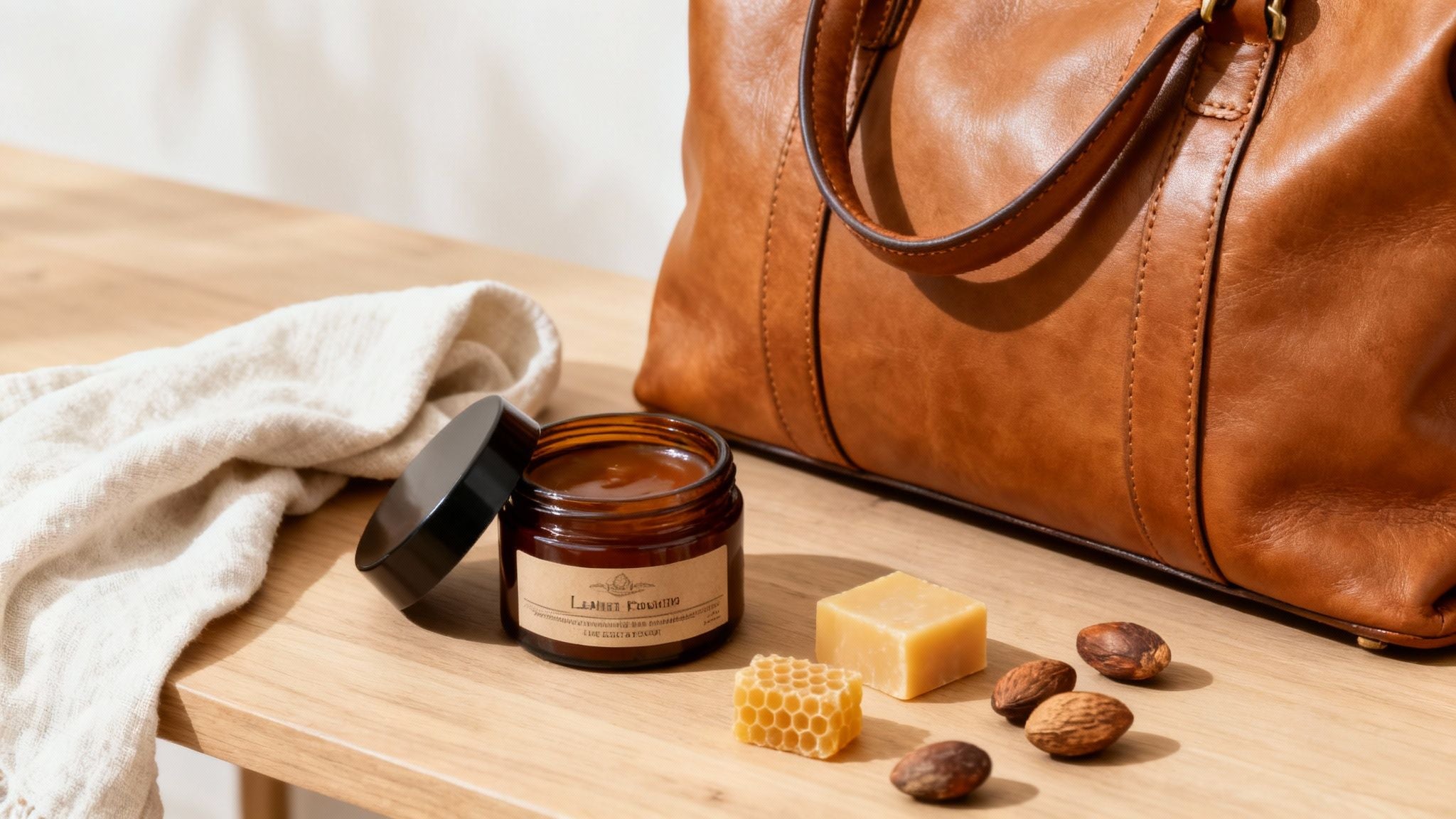How to Clean a Leather Purse Stain Like a Pro
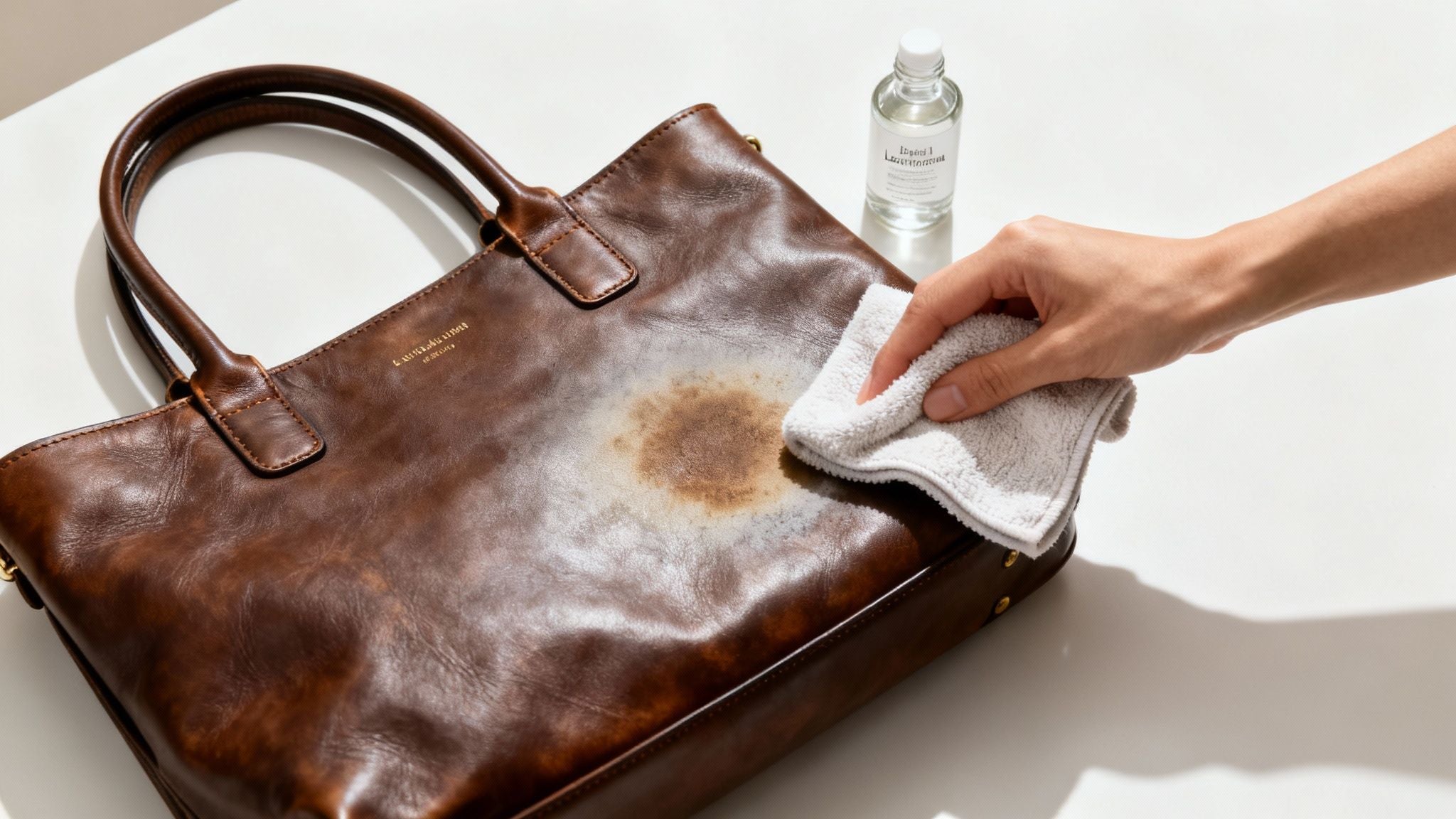
That moment of panic when you spot a stain on your favorite leather bag is all too real. Your first instinct might be to grab the nearest cleaner and scrub away, but please, take a deep breath first. Acting too fast is the quickest way to turn a small, fixable spot into a permanent disaster.
A little prep work goes a long way in protecting your investment. Before you even think about cleaning, you need to identify your leather type, empty the bag, and most importantly, perform a spot test.
Your Pre-Cleaning Leather Care Checklist
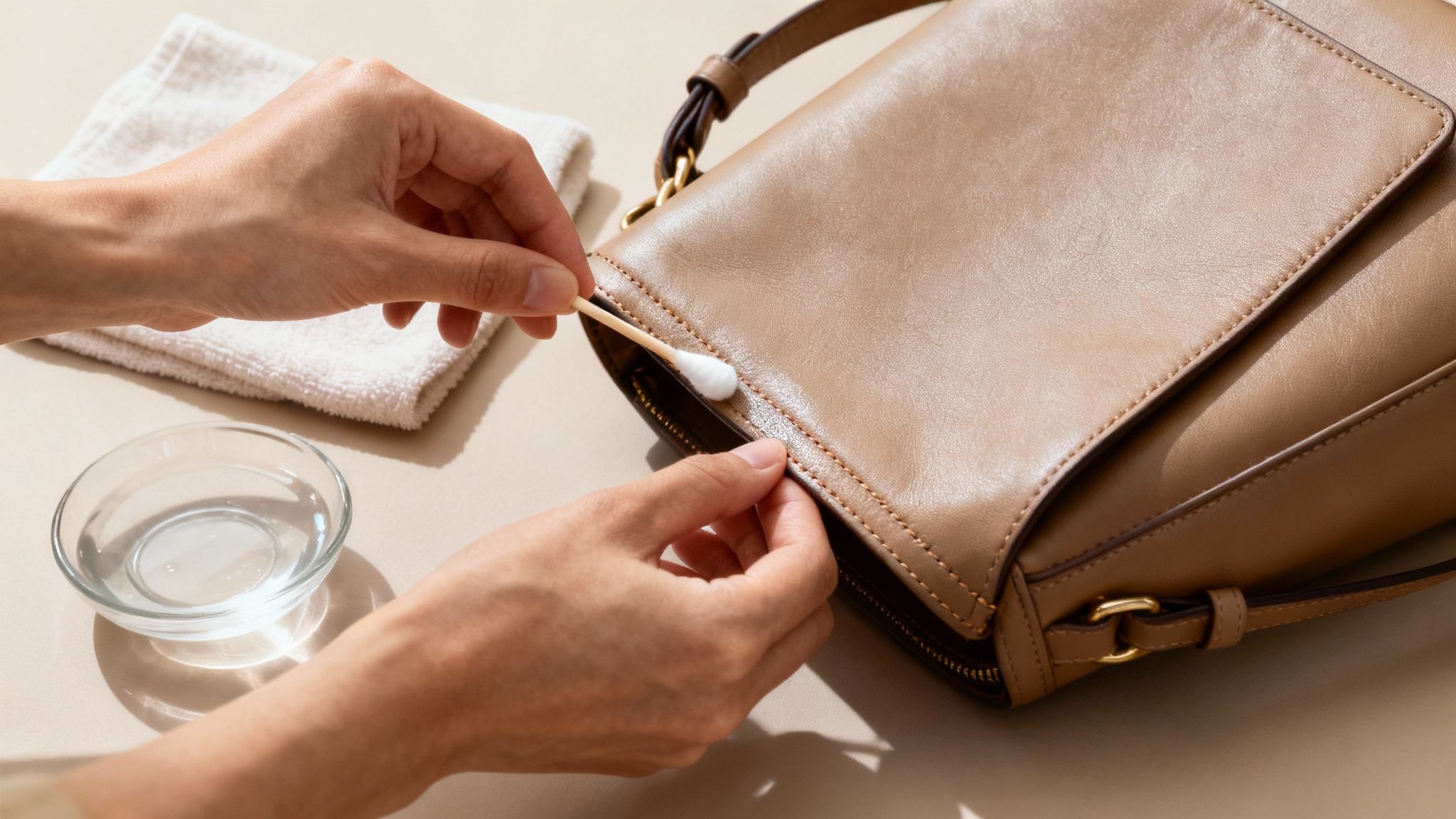
Think of these preliminary steps as your game plan. It’s a simple routine that will safeguard your bag and ensure you get the best results. I’ve seen too many beautiful purses ruined because someone skipped this stage—don’t let that be you.
Know Your Leather Type
First things first, you have to know what you’re working with. Is your purse made from finished or unfinished leather? They look similar but require completely different care.
Finished leather has a protective topcoat, which makes it much more resilient against stains and spills. Unfinished leather, sometimes called aniline, is more natural and porous, meaning it will soak up liquids almost instantly.
The easiest way to tell the difference is a simple water drop test. Just place a single drop of water on a hidden spot.
- Finished Leather: The water droplet will bead up and sit right on the surface.
- Unfinished Leather: The water will soak in quickly, likely darkening the spot.
This single test is absolutely critical. Using the wrong cleaner on a delicate, unfinished hide can cause irreversible damage. If you want to learn more about what makes a quality material, we have a whole guide on what to look for in real leather women's handbags.
Quick Leather Type Identification Guide
Use this simple water drop test to figure out if your purse has finished or unfinished leather before you begin.
| Test Method | Result on Finished Leather | Result on Unfinished Leather | What This Tells You |
|---|---|---|---|
| Water Drop Test | The water bead sits on the surface and does not soak in. | The water absorbs almost immediately and darkens the leather. | Finished leather has a protective coating; unfinished leather is porous and needs gentle care. |
Knowing the difference is half the battle won. Now you can choose your cleaning products with confidence.
Empty and Prep the Bag
With your leather type identified, it's time to empty your purse completely. I mean everything.
Turn it upside down over a trash can and give it a good shake to get rid of all those loose crumbs, old receipts, and whatever else has been hiding in there. For a really thorough job, run a lint roller over the interior lining or use the brush attachment on your vacuum. This is important because any stray dirt or grit can scratch the leather's surface while you're cleaning.
The most crucial step is the spot test. Apply a tiny amount of your chosen cleaning solution to a hidden area—like inside a pocket or under a flap. Wait for it to dry completely to ensure it doesn't cause discoloration or damage.
Seriously, don’t skip this. It’s your insurance policy against a cleaning nightmare. It's surprising how many people miss this, but a survey I saw from a leather crafter noted that around 57% of owners don't regularly clean their bags, often because they're unsure of the right process. To get more comfortable, it’s always a good idea to brush up on the basics of how to clean and care for leather items, since many of the core principles apply to any leather goods.
Choosing Your Cleaning Toolkit: DIY vs. Commercial
Once you know what kind of leather you're working with, it’s time to pick your cleaning solution. You don't always need to rush out and buy a specialized product; sometimes, the best tools are already hiding in your pantry. The choice between a gentle, homemade remedy and a professional-grade leather cleaner really just comes down to the stain's severity and your own comfort level.
For everyday grime or those faint water spots on finished leather, a simple DIY mix is often the perfect first move. It’s gentle, costs next to nothing, and works surprisingly well.
- Mild Soap Solution: Just mix a few drops of a mild, pH-neutral soap (think unscented baby soap) into a bowl of distilled water. It's best to avoid tap water, as the minerals can sometimes leave a residue on the leather.
- How to Apply It: Get a soft microfiber cloth, dampen it with the soapy water, and then wring it out until it’s almost dry. Gently wipe the stained area, then follow up with a second cloth dampened with only distilled water to "rinse" away any leftover soap.
Navigating Stronger DIY Options
For more stubborn stains, you might find articles recommending homemade pastes. A popular one is a mix of cream of tartar and lemon juice for tackling certain types of discoloration. While these can definitely work in some situations, they also come with a few risks.
Ingredients like lemon juice are acidic, which means they can strip the leather's protective finish or even cause discoloration if you leave them on too long or use them on the wrong type of leather. This is why you must always spot test these stronger remedies on a hidden area first, like inside a pocket.
The good news? You don’t need to call in a specialist for every little issue. Practical experience shows that around 80% of typical leather purse stains can be handled right at home with mild soap or the right DIY approach. If you want to learn more, there are some great leather purse cleaning methods on dominileather.com.
When to Bring in the Professionals
If your homemade efforts just aren't cutting it, or you're up against a tough stain like ink or old grease, it’s time to reach for a commercial leather cleaner. The key is to look for products specifically formulated to be pH-balanced for leather.
Stay far away from harsh household cleaners, bleach, or anything with ammonia. These will absolutely dry out and permanently ruin your bag. A quality commercial cleaner is designed to lift stains while protecting the leather’s natural oils and beautiful finish.
A Practical Guide to Common Leather Stains
Different stains call for different strategies, and figuring out what you're up against is always the first step. Think of this as your field guide for the usual suspects you'll find on a leather purse. Moving quickly—and correctly—can be the difference between a quick fix and a permanent mark.
Let's start with one of the worst offenders: an ink mark from a runaway pen. Your first thought might be to scrub it, but please don't! That will only make it worse. Instead, the trick is to lightly dampen a cotton swab with rubbing alcohol and gently dab the spot. Wiping is off-limits. The idea is to lift the ink out of the leather, not smear it deeper into the grain.
Tackling Grease and Water Stains
Grease and oil stains, whether from hand lotion or a stray french fry, are another common headache. For these, cornstarch is your best friend. Sprinkle a generous amount right on the spot as soon as you can. Let it sit overnight; the powder works like a tiny sponge, pulling the oil out before it can set for good. In the morning, you can just brush it away with a soft cloth.
Water rings are funny because the solution feels a little backward. To get rid of a water stain, you actually need a bit more water. Dampen a clean cloth with distilled water and gently blend the spot outward from the center, feathering the edges. This helps the whole area dry more evenly, which gets rid of that harsh line.
Remember: The key to removing almost any stain from a leather purse is a gentle hand. Aggressive scrubbing will almost always make the problem worse by damaging the leather's finish or pushing the stain deeper.
This handy infographic helps simplify the choice between a home remedy and a commercial cleaner, depending on how serious the stain is.
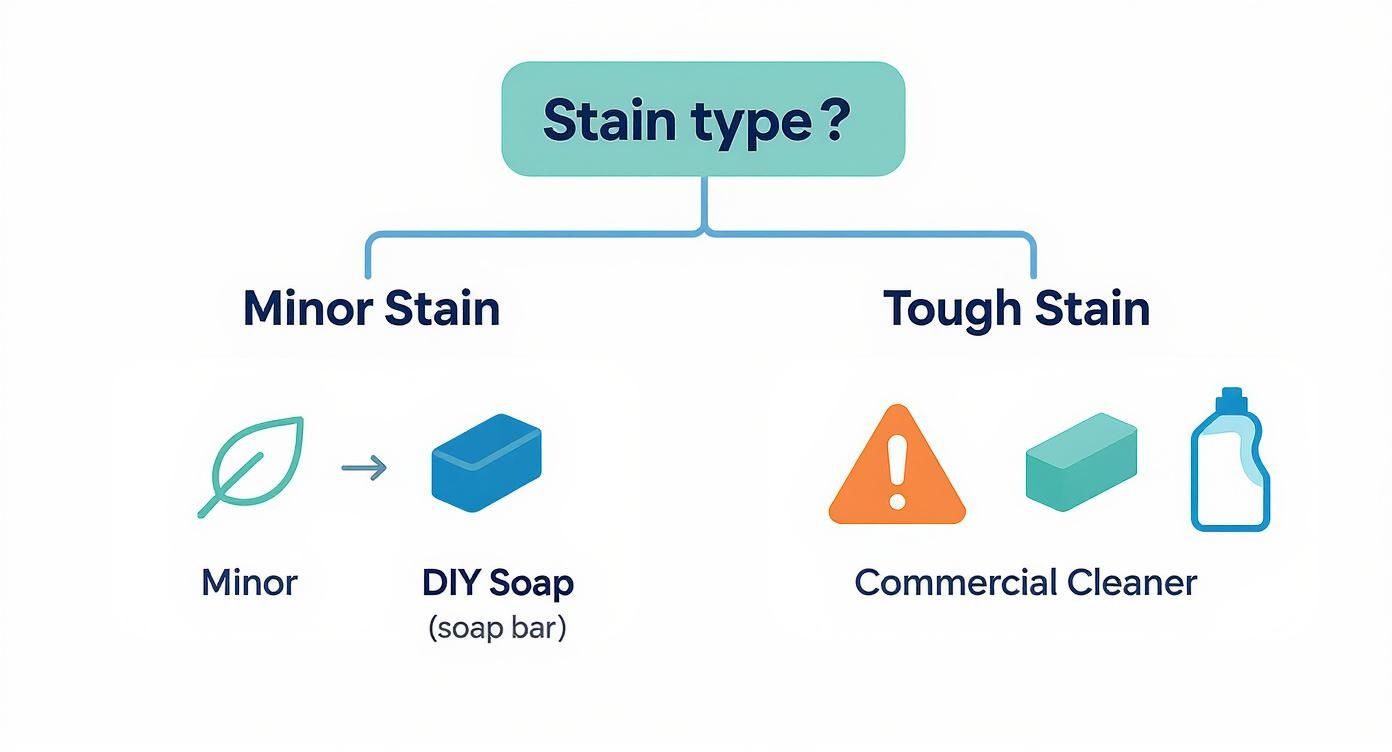
As you can see, your first move for minor issues is a simple DIY solution. You should only reach for stronger products when you're dealing with a really stubborn stain. For a wider look at tackling spills, you can find some great advice on how to clean your car seats (including leather). The same principles often work just as well for other leather goods.
Handling High-Risk Spills Like Red Wine
Few things make a handbag owner’s heart stop faster than a splash of red wine. That dark red liquid is at the top of the high-risk list for a reason—its tannins and deep pigments are notorious for creating permanent marks on leather.
Whether you can save your bag comes down to one critical factor: the leather's finish. A frantic, incorrect cleaning attempt can actually do more harm than good, often setting the stain for good.
Immediate Action for Finished Leather
If your purse is made of finished leather, you have a fighting chance, but you absolutely must act fast. That protective topcoat is your best friend, buying you precious time before the wine soaks deep into the material.
Your first move is to blot, not rub. Grab a clean, dry microfiber cloth and gently dab at the spill. Rubbing will only spread the wine around and push it deeper into the leather’s grain.
Once you've blotted up the excess, you can move on to a very specific, gentle cleaning solution.
- Mix one part mild, moisturizing soap with ten parts distilled water.
- Lightly dampen a fresh, clean cloth with this solution and gently blot the stain, always working from the outside edge inward to prevent it from spreading.
- Follow up immediately by blotting with a new cloth dampened only with distilled water to rinse away any soap residue.
Still see a faint mark? A paste made from one part cream of tartar and one part lemon juice can sometimes lift the rest. Apply it for just 10 minutes, but spot test this somewhere hidden first to be safe.
When it comes to high-risk spills on unfinished, porous leather, the best advice is to blot the excess liquid immediately and then stop. Unfinished leather absorbs stains almost instantly. Any DIY cleaning attempts usually lead to irreversible water marks or discoloration. In this situation, your best bet is to call a professional leather cleaner right away.
Knowing your limits is key to saving your bag. Sometimes, the smartest step is knowing when to hand the problem over to an expert. While tackling minor stains at home is often possible, it's a completely different situation from a full wash. You can find more information in our guide on whether you can wash a leather purse.
The Final Step: Conditioning and Protecting Your Purse
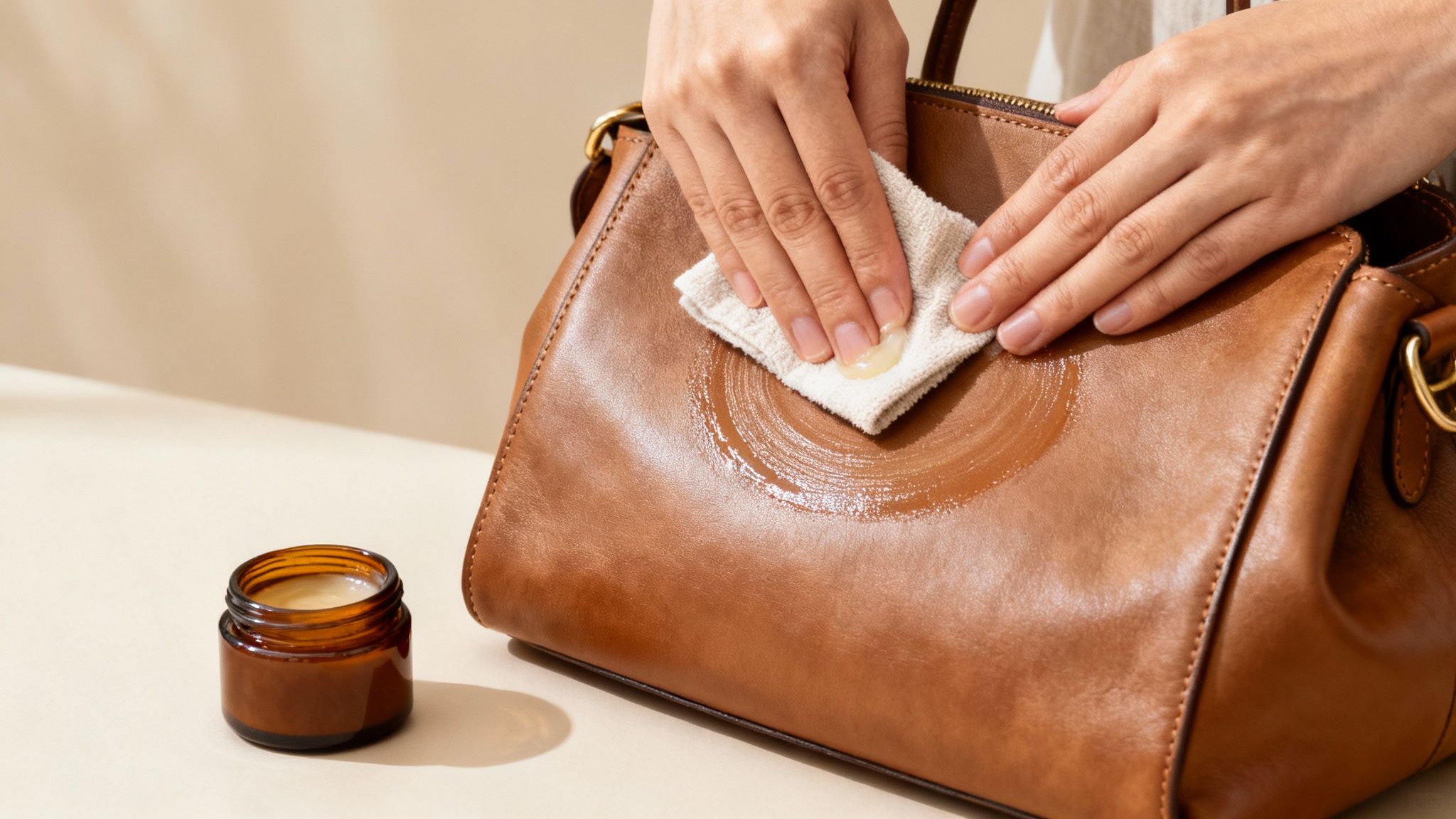
Getting a stain out of your leather purse is a huge relief, but the job isn't quite done. Even the most careful cleaning can strip away some of the leather's natural, essential oils. It leaves the material thirsty and vulnerable.
Skipping the conditioning step is like washing your hair but skipping the conditioner. It leaves the fibers dry, brittle, and much more likely to be damaged down the road. This is the non-negotiable final touch that brings your bag back to life, restores its buttery soft texture, and adds a crucial layer of protection against future accidents.
Choosing the Right Leather Conditioner
Not all conditioners are made equal. You're looking for a product that truly nourishes the leather from within, not one that just coats the surface with a heavy, pore-clogging film.
When you're shopping around, look for conditioners that list natural oils as key ingredients. Try to steer clear of products with heavy waxes or silicones, as these can suffocate the leather and prevent it from breathing naturally.
To really get the best results, check out our in-depth guide on the best leather conditioner for handbags. It breaks down exactly what to look for based on the specific type of leather your purse is made from.
The Correct Application Technique
How you apply the conditioner is just as important as which one you choose. The goal here is gentle nourishment, not complete saturation.
- Start by putting a small, pea-sized amount of conditioner onto a clean, soft microfiber cloth.
- Gently massage the conditioner into the leather using small, circular motions. This helps the product absorb deeply and evenly.
- Now, let it sit. The leather needs time to drink it all in, which can take anywhere from 30 minutes to a few hours.
- Once it’s fully absorbed, grab a second clean, dry cloth and gently buff the entire surface to a beautiful, subtle sheen.
This final buffing step is the secret to a professional finish. It whisks away any leftover product and brings out the leather’s natural luster without making it look greasy or artificially shiny. Your purse will look refreshed, feel amazing, and be better protected for whatever comes next.
Common Questions About Leather Purse Stains
Even with a step-by-step guide, it's totally normal to have a few last-minute questions before you start working on a stain. Let's walk through some of the most common worries I hear so you can feel completely confident.
One of the biggest questions is how often a leather bag really needs to be cleaned. For day-to-day care, a quick wipe-down with a dry microfiber cloth every week or so is more than enough to handle surface dust. A deeper clean with a proper leather solution is something you only need to worry about every few months, or, of course, when a spill happens.
Can I Use Household Cleaners?
I know how tempting it is to reach for a Clorox wipe or whatever all-purpose spray is under your sink, but please, resist the urge. These products are packed with harsh chemicals like ammonia and bleach that will strip the leather’s natural oils and can ruin its protective finish. It's always best to stick with a gentle, pH-neutral soap or a cleaner made specifically for leather.
What about things like white vinegar or rubbing alcohol? While they can sometimes work on very specific stains (like ink), they have to be used with extreme caution. They’re solvents, and if you use too much, they can seriously dry out and damage the leather.
Key Takeaway: The wrong cleaner can do far more damage than the original stain. Always, always test any cleaning product on a small, hidden spot first to see how your bag reacts before you go after the real problem.
What About Suede or Unfinished Leather?
Suede and other unfinished leathers are a completely different story. Their surfaces are incredibly porous, which means water is the enemy—it will almost always leave a stain of its own.
- For Suede: Never use water. Your best tools are a dedicated suede brush to gently lift away dry dirt and a simple pencil eraser, which can work wonders on small, stubborn spots.
- For Unfinished Leather: Blot spills the second they happen and steer clear of DIY cleaning solutions. These delicate leathers often need a professional touch to avoid setting the stain for good.
And what about that old, mysterious stain you just noticed? For set-in stains where you don't know the cause, always start with the mildest method possible: a damp cloth with just a tiny drop of gentle soap. If that doesn't make a dent, it’s much safer to consult a professional leather cleaning service than to risk causing irreversible damage with stronger chemicals.
At The Bag Icon, we believe luxury should be accessible and your favorite handbag should last a lifetime. Explore our collection of high-quality, affordable leather purses and find your next statement piece at https://www.thebagicon.com.
